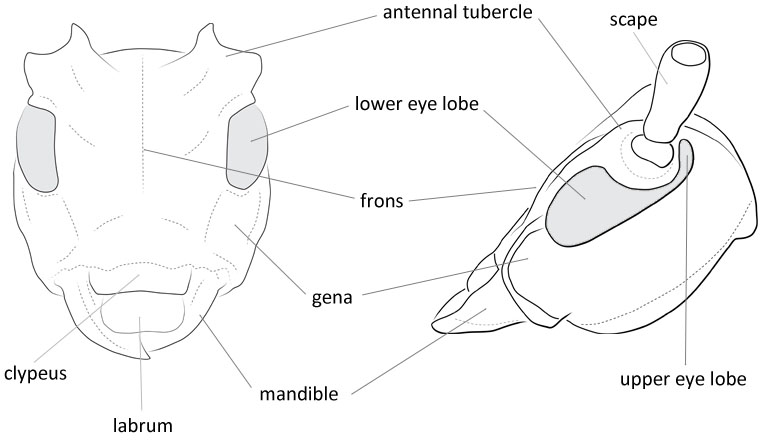Body length: 8–20 mm.
Eyes: eye interommatidial setaeseta:
a sclerotized hair-like projection of the cuticle
absent, eye deeply emarginateemarginate:
notched at the margin > half width, eye ommatidial density fine.
> half width, eye ommatidial density fine.
Antennaeantenna:
in larval and adult insects, paired segmented appendages, borne one on each side of the head, functioning as sense organs and bearing a large number of sensilla
: antennal length reaches between basebase:
the part of any appendage or structure that is nearest the body
and end of elytraelytron:
the leathery forewing of beetles, serving as a covering for the hind wings, commonly meeting opposite elytron in a straight line down the middle of the dorsum in repose
, antennal flagellar segments elongateelongate:
much longer than wide
, scapescape:
the first proximal segment of the antenna smooth/punctate at apexapex:
smooth/punctate at apexapex:
end of any structure distad to the base
, antennal scapescape:
the first proximal segment of the antenna ≥ segment 3.
≥ segment 3.
Pronotumpronotum:
the upper and dorsal part of the prothorax
: pronotumpronotum:
the upper and dorsal part of the prothorax
shape transversetransverse:
broader than long
, pronotumpronotum:
the upper and dorsal part of the prothorax
lateral armature absent.
Prosternum: prosternal processprosternal process:
a posterior extension of the prosternum between the coxae not dilated at apexapex:
not dilated at apexapex:
end of any structure distad to the base
, procoxal cavities open posteriorly.
Elytraelytron:
the leathery forewing of beetles, serving as a covering for the hind wings, commonly meeting opposite elytron in a straight line down the middle of the dorsum in repose
: elytral length reaching or close to end of abdomen, elytral apicesapex:
end of any structure distad to the base
rounded or truncatetruncate:
cut off squarely at the tip
, elytral color brown, elytral color pattern present.
Legs: visible tarsomerestarsomere:
subdivision or article of the tarsus, usually numbering from two to five : 4, femora clavateclavate:
: 4, femora clavateclavate:
thickening gradually toward the tip
, protibial spursprotibial spur:
sclerotized spine(s) located at the distal tibia; can be single, double, or absent : 2, tarsal clawstarsal claw:
: 2, tarsal clawstarsal claw:
usually paired claws of the pretarsus, at the distal end of the leg with tooth/bump near claw basebase:
with tooth/bump near claw basebase:
the part of any appendage or structure that is nearest the body
.
Form depressed. Head with eyes emarginateemarginate:
notched at the margin but not embracing antennal insertion; antennaeantenna:
but not embracing antennal insertion; antennaeantenna:
in larval and adult insects, paired segmented appendages, borne one on each side of the head, functioning as sense organs and bearing a large number of sensilla
slender, filiformfiliform:
threadlike, i.e., slender and of equal diameter, being commonly applied to antennae
, scarcely reaching to middle of elytraelytron:
the leathery forewing of beetles, serving as a covering for the hind wings, commonly meeting opposite elytron in a straight line down the middle of the dorsum in repose
in male, 11-segmented, third segment nearly twice as long as fourth. Pronotumpronotum:
the upper and dorsal part of the prothorax
with disk elevated, bearing polished callosities, basebase:
the part of any appendage or structure that is nearest the body
bisinuate; mesonotum with a large, undivided, finely striatestriate:
marked with parallel, fine, longitudinal, impressed lines or furrows
stridulatory surface; prosternum with a broad, flat intercoxal process; metasternum with coxae enclosed, scent pores lacking. Elytraelytron:
the leathery forewing of beetles, serving as a covering for the hind wings, commonly meeting opposite elytron in a straight line down the middle of the dorsum in repose
with apicesapex:
end of any structure distad to the base
separately rounded. Legs moderate; femora clavateclavate:
thickening gradually toward the tip
; tarsal clawstarsal claw:
usually paired claws of the pretarsus, at the distal end of the leg toothed (Linsley 1964Linsley 1964:
toothed (Linsley 1964Linsley 1964:
Linsley EG. 1964. The Cerambycidae of North America. Part V. Taxonomy and Classification of the Subfamily Cerambycinae, Tribes Callichromini Through Ancylocerini. University of California Publications in Entomology, Vol. 22. 197 pp.).
The obviously toothed tarsal clawstarsal claw:
usually paired claws of the pretarsus, at the distal end of the leg will distinguish this genus among cerambycine conifer feeders.
will distinguish this genus among cerambycine conifer feeders.
Endemic to Europe but through transport is now cosmopolitan: Asia, North Africa, South Africa, Asia Minor, Australia, New Zealand, South America, eastern North America (especially along the Atlantic seaboard and Gulf Coast)
Abies, Larix, Pinus, Picea, Pseudotsuga. Some hardwoods in records but very rare or incidental.
Monotypic. Native to Europe but Introduced into most of the world with hosts. Will ovipositoviposit:
to deposit or lay eggs or ova
in dry seasoned conifers, leading to more transport.
Callidium Fabricius, 1775
Hylotrupes Audinet-Serville, 1834